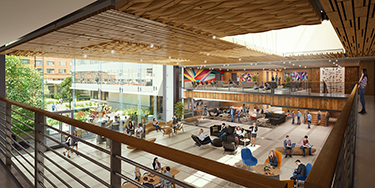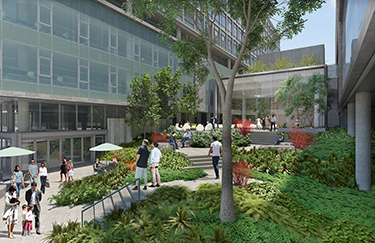|
Subscribe / Renew |
|
|
Contact Us |
|
| ► Subscribe to our Free Weekly Newsletter | |
| home | Welcome, sign in or click here to subscribe. | login |
Real Estate
| |
 |
February 22, 2018
Workplace 2.0 for millennials and Gen Z
Seco Development

Spencer
|
In the coming decades, artificial intelligence and automation are set to transform the way we work. At the same time, millennials are poised to make up half of the global workforce by the year 2020 and Generation Z is just beginning to make its mark — both generations represent the fresh talent employers are eager to attract.
Now is a critical time for those of us in the business of designing, developing, leasing and managing office space to consider the way we will work and use this space in the future. Technological and social changes spurred by these innovations and generational shifts will redefine workplace norms and employee expectations.
These changes demand a reimagination of the physical work environment.
However, it is equally important that companies also consider employees' overall workplace experience. From what studies have shown thus far, we recognize that the rising generations of workers seek an environment that promotes teamwork, innovation and collaboration — in a desirable setting — with cutting-edge systems and infrastructure.
Flexible workspaces, trailblazing technology, access to alternative transportation, proximity to the outdoors, and activities that help balance personal and professional demands are some of the elements the next generation is expected to look for in a work environment. The extent to which such factors are considered in workplace design will most definitely contribute to the attraction and retention of top talent.
Innovative, engaging spaces
According to CBRE's 2016 report, "Millennials: Myths and Realities," a survey of 13,000 millennials worldwide by Ipsos found that 33 percent of millennial workers prefer collaborative workplace environments. Because of this, creating an office with flexible spaces to accommodate groups large or small, and promote collaboration or individual efficiency depending on the task at hand is essential for future workplaces. Additionally, large, operable windows, functional terraces and even outdoor meeting spaces that allow for customization to group size and working preferences could be seen as particularly attractive.
Health and wellness
Amenities tailored toward the active healthy lifestyle movement are increasingly being offered at top companies, and are more commonly a deciding factor in attracting talent. With the growing demands of various jobs and a blurring of the line between work and personal life, the chronic sources of stress for workers and their serious health effects often lead to fatigue, diminished productivity and work dissatisfaction.
Those of us designing, developing, leasing and managing space have the power to directly combat these issues by building health and wellness amenities into workplaces.
Today, we spend roughly half of our waking hours working. We should look to create spaces that are more than just an area for conducting business — they should be places that contribute to our well-being. Preference should be given to locations that connect with nature and offer easy access to open, green or recreational spaces. In doing so, we present an opportunity to enhance employee engagement, retention and productivity — while also gaining a potential competitive advantage.
Technology, connectivity
More than any previous workforce, today's employees are hyper-connected, thanks to advanced collaboration tools, enhanced social networking and use of mobile technology. Next-gen infrastructure such as fiber networks supporting 100-gigabit data speeds for cutting-edge applications like 4k and 8k video conferencing or virtual reality and augmented reality — one-time extraneous technologies — are now poised to change the way people interact.
Transportation options
While many of us expected to have flying cars by now, a future of fully autonomous vehicles is within view and set to fundamentally reshape where we live and how we commute. Even still, access to a wide range of transportation options, such as light rail, heavy rail, bus, bike and even water taxis, can help attract younger employees that are more likely to use a rideshare service than they are to own a car.
Moreover, that same Ipsos study for CBRE found half of millennials are only willing to tolerate a 30-minute commute, and prefer a workplace and office location that can accommodate that need. Rather than living in a more affordable suburb and battling gridlock in traffic-laden cities, the well-connected "urban suburbs" provide the best of both worlds.
The rise of urban suburbs
While much has been said about millennials' desire to live and work downtown, there's still a lot we don't know about the future preferences of Gen Z workers. This generation of workers is just now beginning to enter the workforce with aplomb.
What we do know is that some of the largest and most successful companies are doubling down on suburban campus developments that look a lot more urban. For example, Microsoft is redeveloping the original core of its 78-acre Redmond office campus. The tech giant estimates the 3 million-square-foot development will take roughly three years and cost a whopping $3 billion. But, they cite the connectedness of the campus with easy access to downtown Seattle and surrounding areas as attractive for their employees.
In Silicon Valley — home to the likes of Apple, Google and Facebook — people are flocking to nearby suburbs for relative affordability and more manageable commutes. Nine of Redfin's 2018 Top Ten Hottest Neighborhoods are in San Jose, California. With features like easy commutes, farmer's markets and proximity to parks or the beach, San Jose and other Silicon Valley communities represent the characteristics we value when searching for a place to live.
Companies are listening to their employees while also studying the next generation of workers. In turn, they want to locate their offices in an environment where employees can afford to live, while also having access to incredible technology and myriad health and wellness amenities. Companies are wise to consider this when creating new office spaces if they want to future proof their investment and foster an environment where talent can thrive and feel engaged.
Creating an attractive and sustainable workplace that looks more like the future than the past is one of the most meaningful things organizations can do to secure and retain top talent. These key details were given thorough attention and careful consideration by Seco Development and ZGF Architects in creating the Southport Office Campus.
By focusing on Southport's strategic location and integrating modern and beneficial amenities into the rising mixed-use, urban lifestyle community, we are fixated on creating a unique workplace of the future on the shores of Lake Washington.
Kip Spencer, a 28-year veteran of the commercial real estate industry, is the director of leasing and marketing at Seco Development. Seco has owned land for over 35 years in Seattle, Bellevue, Kirkland and Renton.
Other Stories:
- Building a new urban fabric along Pike-Pine
- Survey -- Martin Selig Real Estate
- Survey -- Schnitzer West
- Survey -- Urban Renaissance Group
- Survey -- Continental Properties
- Office market tightening, demand keeps rising
- Institutions take over the industrial market
- Retailers adapt to millennials, e-commerce
- Don’t get too comfortable with hotels
- 100,000 apartment units are coming — now what?
- Here’s how to solve the condominium conundrum
- Neighborhood hub emerging from old shopping center
- Moratorium has Bainbridge projects at a standstill
- We need to tackle our top public safety concern: URM buildings
- Reimagining the urban edge along Aurora
- Yesler: a model for inclusive urban development
- Seattle retools for the future at Fifth and Virginia
- A balancing act: development, transportation, place making
- Survey -- Capitol Hill Housing




